Abstract
To enhance the navigation and control efficiency of mobile robots in the field of health monitoring, a novel path planning and control strategy for mobile robots with uncertain dynamics based on improved artificial potential fields is proposed in this paper. Specifically, we propose an attractive potential field rotation method to overcome the limitation that traditional artificial potential fields tend to fall into local minima. Then, we define a new class of attractive potential fields to address the goals non-reachable with obstacles nearby (GNRON) and collisions caused by excessive attractive force at long distances from the target point. Furthermore, a control law is proposed for the mobile robot with uncertain dynamics, and the stability of the closed-loop system is rigorously proven using the Lyapunov method. Finally, the feasibility and effectiveness of the proposed method are verified by simulations and experiments.
Keywords:
path planning; obstacle avoidance; Lyapunov design; artificial potential field; mobile robot; health monitoring MSC:
93A99
1. Introduction
Nowadays, mobile robots have been widely used in many fields such as industrial production, warehouse logistics, and security inspection [1,2,3]. The advent of rapidly developing healthcare service technology has led to a surge in the popularity of mobile robots in health monitoring. These robots provide convenient and beneficial solutions for individuals [4,5,6,7,8,9], improving their quality of life and promoting better health outcomes. As the global aging trend continues to intensify, the market for autonomous mobile robots for health monitoring will become increasingly widespread [10]. The safety and reliability of health monitoring is one of the most critical aspects of system design. This implies that mobile robots should plan their action paths in real time and accurately in unstructured environments such as homes and hospitals to avoid collisions and safety accidents and complete tasks efficiently. Therefore, path planning has become a key issue in the field of mobile robot research.
Artificial potential field (APF) [11] is one of the most commonly utilized local path planning methods. Its basic principle is to construct virtual attractive and repulsive fields in the robot’s motion space. The attractive force makes the robot converge toward the target, and the repulsive force serves to repel it from obstacles. This method is characterized by a straightforward structure, which enables real-time control of the lower layer [12]. The robot reproduces the therapist’s motion trajectory through a potential field function to provide rehabilitation and assisted exercises for the patient in [13]. The velocity differential potential field and acceleration differential potential field are proposed based on APF to ensure the overtaking safety of self-driving vehicles in [14]. The traditional attractive potential field is modified, and a localization accuracy field is introduced to achieve a balance between localization accuracy and obstacle avoidance in [15]. The repulsive potential field is made orthogonal to the attractive potential field to improve the navigation efficiency of the mobile robot in [16]. The APF method is combined with sliding mode control to achieve finite time convergence in the presence of bounded disturbances in [17].
However, in the above studies, the existence of a local minimum can result in the failure of the planning task. In addition, if there are obstacles near the destination, it will cause the mobile robot to fall into the local optimal solution before reaching the target point. This phenomenon is usually called the problem of goals non-reachable with obstacles nearby (GNRON) [18,19]. Furthermore, the robot may collide with obstacles when it is too far away from the target point due to excessive attraction. To solve the local minima problem, the potential field function is constructed by the harmonic function [20], but the computation time of this method increases linearly with the increase in the number of obstacles. Subsequent improvements to the algorithms have been proposed, and related work is categorized into four main areas according to their control strategies. The first method is to add virtual target points or obstacles to attract or repel the mobile robot to approach the target or move away from the local minima [21,22,23]. The second approach entails the implementation of suitable modifications to the attractive and repulsive functions [24,25,26,27]. The third approach introduces supplementary control within the potential field [28,29,30,31]. The fourth approach combines APF with other planning algorithms, including A* [32,33,34], RRT* (Rapidly exploring Random Tree Star) [35,36], MPC (Model Predictive Control) [37,38], and GA (Genetic Algorithm) [39].
An intriguing technique has been developed in the aforementioned research to overcome the limitations of the conventional artificial potential field by means of a rotation [19]. To address the issue of local minima, a safe potential field with vortex and repulsive potential switching is proposed in [40]. Nevertheless, existing techniques for rotating potential fields mainly focus on rotating the repulsive potential field [41], with limited attention given to the rotation of the attractive potential field. Moreover, most studies assume that the robot’s state can be acquired in real time. In hospital and home environments, mobile robots often face challenges related to uncertainties in kinematic and dynamic modeling, mechanical constraints, and measurement noise, making such assumptions potentially unrealistic. Therefore, this paper focuses on the path planning method and control of mobile robots with uncertain dynamics based on an improved artificial potential field and its application in health monitoring. The key contributions of this paper are threefold:
- A class of attractive potential fields is tailored to address the GNRON problem and to circumvent collisions caused by excessive attraction at considerable distances from the target point, thereby ensuring the safety of the intended trajectory.
- The issue of mobile robots falling into local minima is handled by the proposed attractive potential field rotation method.
- An adaptive controller is employed for a mobile robot with unknown inertial parameters and dynamic system perturbations. The stability of the closed-loop system and the boundedness of the estimation error are proven using the Lyapunov stability theory. The effectiveness and feasibility of the proposed planning and control strategy are then validated through simulations and experiments.
The rest of this paper is organized as follows. Section 2 covers the preliminaries and problem statement. Our methodology is elaborated in Section 3, followed by the simulations and experimental validation presented in Section 4. Section 5 discusses the findings of the study. Finally, Section 6 provides the conclusions of this paper.
We use to denote the set of real numbers, to denote the n-dimensional Euclidean space, and to represent the set of real matrices. denotes the Euclidean norm of a vector. The superscripts “” and “” denote the matrix inverse and transposition, respectively.
2. Preliminaries and Problem Statement
Kinematic and Dynamic Models
We consider a model of a nonholonomic mobile robot with its reference position point p located at the center of the axis connecting its wheels. The mobile robot has two rear wheels independently controlled by motors and a front caster wheel, as illustrated in Figure 1.
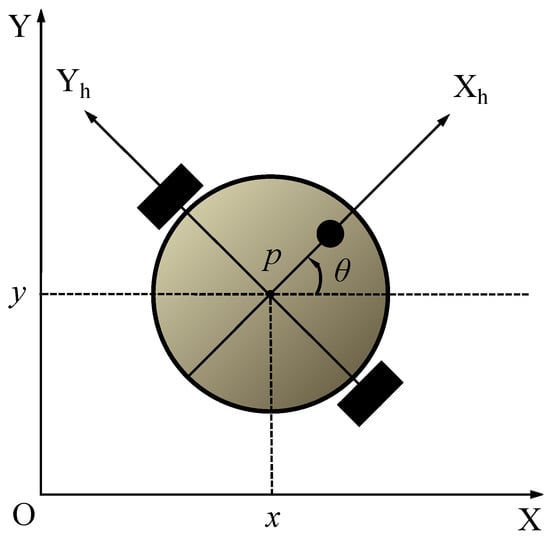
Figure 1.
Differential mobile robot model.
It is assumed that the mobile robot’s center of mass coincides with its geometric center, the wheels of the mobile robot are perpendicular to the ground, and there is only pure rolling between the wheels and the ground without lateral sliding. These assumptions imply that the robot’s lateral velocity is always zero. This condition is commonly referred to as the nonholonomic constraint and can be expressed as
where x and y represent the generalized coordinates of the point p in the global coordinate frame, and represents the heading angle of the mobile robot, i.e., the angle of the heading direction of the mobile robot relative to the -axis. The kinematics of the mobile robot can be described as
where v and are the linear and angular velocities of the mobile robot, respectively. The system (1) can be rewritten as
with
where denotes the position and the heading angle of the mobile robot, and denotes the velocity vector.
According to the Euler–Lagrangian formulation and [42,43], the dynamic model of the mobile robot can be demonstrated as
where is a positive definite symmetric inertial matrix, represents centripetal and Coriolis torque, is an input transformation matrix, represents unknown bounded disturbances including unstructured unmodelled dynamics, and is the torque applied to the left and right wheels. It is assumed that is a matrix of full rank and the dynamic model (3) satisfies the following properties:
Property 1.
is a skew-symmetric matrix.
Property 2.
For any differentiable vector ξ, , where is a known regressor matrix of , , ξ and , and is an inertia parameter vector of the system.
3. Path Planning and Control Strategy Design for Mobile Robots with Uncertain Dynamics
3.1. Traditional Artificial Potential Field Method
In the 1980s, the APF method was proposed in [11]. This approach models the mobile robot as a positively charged particle that is attracted to a negatively charged target point while being repelled by positively charged obstacles. The robot’s movement is guided by the net force, which is the vector sum of these individual attractive and repulsive forces. The attractive potential field and corresponding attractive force are mathematically represented as follows:
where is the positive gain coefficient of the attractive potential field, and are the current position of the mobile robot and target point, respectively, and is the relative distance between the mobile robot and target point, i.e., . The repulsive potential field and repulsive force can be expressed as
where is the positive gain coefficient of the repulsive potential field, is the shortest distance between the mobile robot and the obstacle, denotes the safe distance between the mobile robot and the obstacle, and it should be noted that the mobile robot is only affected by the repulsive force within this distance. The robot will move in the direction of the resultant force of attraction and repulsion, and the resultant force can be expressed as
where i represents the index of an obstacle exerting a repelling effect on the robot, and n denotes the total number of such obstacles. When a mobile robot enters the domain influenced by the repulsive forces of several obstacles, the cumulative repulsive force acting on it is the vector sum of the individual repulsive forces from each obstacle.
The APF method is known for its simple structure, which facilitates real-time control of the underlying layer. It exhibits reduced computational resources and time consumption, while also generating relatively smooth paths. Nevertheless, this approach exhibits certain limitations in practical path planning for mobile robots. A major challenge is the occurrence of local minima, which frequently leads to the failure of the planning task. Additionally, most previous studies have positioned the target point outside the repulsive potential field of obstacles. In contrast, when the target is located within this repulsive field, the mobile robot experiences a gradual reduction in attractive force as it approaches the target. This diminishing force makes it increasingly challenging for the robot to overcome the repulsive influence of obstacles, ultimately leading to the problem of GNRON, as illustrated in Figure 2.
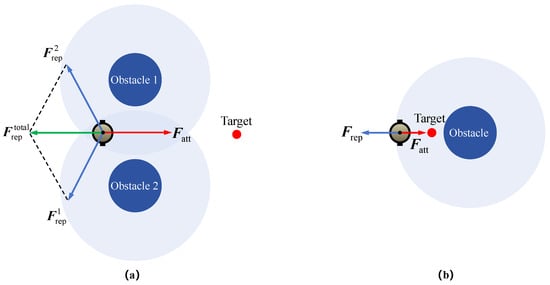
Figure 2.
The mobile robot falls into a local minimum. The problem of GNRON.
3.2. Improved Attractive Potential Field
In addition to the previously outlined limitations, it is important to note that in traditional APF, if the mobile robot is situated at a considerable distance from its intended destination, the attraction of the destination to the robot may be excessive, potentially resulting in safety risks, such as collisions in unstructured scenarios, particularly in some large healthcare facilities. Therefore, these shortcomings of traditional methodologies warrant further investigation. In this paper, we assume that all obstacles are circular to simplify the Lyapunov-based analysis, allowing the direct use of Euclidean distance to represent the distance between the robot and the obstacles.
To address the issues of GNRON and the collision problem resulting from an excessive attractive force during long-distance planning, we propose a novel class of attractive potential fields, which can be expressed as
where is the positive gain coefficient of the attractive potential field, and describes a smooth relationship between the distance of the robot from the target point with the following characteristics: > 0. strictly decreasing on (0, ) and strictly increasing on (, +∞). is contingent upon the relative distance of the target point from nearby obstacles. indicates the safe distance that should be maintained between the mobile robot and any obstacles, within which the robot experiences the repulsive force. . And , where is a positive constant by considering that the attractive force exerted on the mobile robot before guidance cannot be infinite due to the limited capacity of mobile robots.
Remark 1.
In contrast to existing techniques that enhance APF-based repulsive potential fields, our approach preserves the traditional repulsive potential field construction methodology while introducing improvements to the attractive potential field for two key reasons. First, the most common solution to the GNRON problem is to incorporate the relative distance between the robot and the target into the repulsive potential field [18,26]. However, this increases the repulsive force as the distance between the robot and the target point increases, which is more likely to result in a local minimum. Second, rotating the repulsive potential field to avoid local minima represents a promising approach [19,40,41]. However, in practical mobile robot operations, it is necessary to consider the volume and geometry of both the robot and the obstacle. In these situations, the traditional repulsive potential field, which directs forces toward the robot, may be a safer and more effective choice. This is an avenue we plan to explore further in future research.
Remark 2.
To address the problem of excessive attractive force during long-distance planning, the attractive potential field needs to be modified. The attractive potential field function introduces a segmentation threshold in [25,27,40], but this approach causes a discontinuity at the segmentation point, leading to abrupt changes in the robot’s velocity or jitter at that point. Moreover, this threshold is empirically determined and lacks generalizability. In contrast, the method proposed in this paper overcomes these limitations by ensuring the attractive function remains smooth.
Remark 3.
Using nonlinear functions to reconstruct the attractive potential field can effectively mitigate the GNRON and the issue of excessive attraction caused by large distances in [24]. However, this method will cause the attractive force function to not be smooth enough at the inflection point, leading to the persistence of jitter and sudden velocity change problems. The enhanced attractive potential field function proposed in this paper, which avoids the need for segmentation and is generally built using exponential and power functions, provides a refined synthesis and improvement over similar methods.
3.3. Attractive Potential Field Rotation Method
The attractive potential rotation method proposed in this paper aims to enable the mobile robot to escape local minima, particularly in scenarios involving three-point collinear configurations. The attractive potential field rotation is activated when the robot is affected by the repulsive force of an obstacle during its movement toward the target point, as illustrated in Figure 3. The proposed new potential field can be described as
where represents the resultant potential field, which includes both attractive and repulsive potential fields, denotes the repulsive potential generated by the i-th obstacle to the robot. is the newly introduced attractive potential field, specifically designed to address the issue of local minima, which can be expressed as
where can take the form of either (4) or (8). To facilitate distinction and subsequent algorithmic comparison, we designate the process of rotating the traditional attractive potential field as RT-APF. Similarly, we designate the process of rotating our improved attractive potential field as RI-APF. represents the rotation matrix corresponding to the attractive potential field. This matrix enables a smooth transition between disparate potential states through the application of trigonometric functions and a continuous rotation angle . The relationship is as follows:
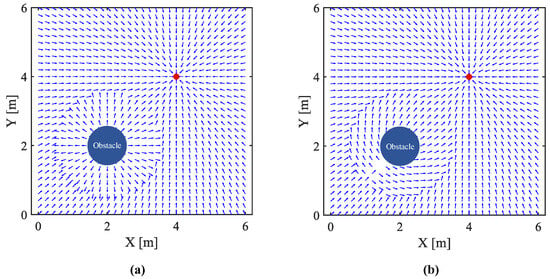
Figure 3.
This illustration compares the two-dimensional potential fields of the traditional APF and the attractive potential field rotation method. The starting point is located at (0,0), the target is at (4,4), and the obstacle is placed at (2,2). Distribution of attractive and repulsive potential fields for traditional APF. Distribution of attractive and repulsive potential fields for the attractive potential field rotation method.
In practical applications, it is essential for the mobile robot to constrain with a saturation function due to its nonholonomic constraints. We define the maximum rotation angle of the attractive potential field as . The corresponding saturation function is defined as
Then, the rotation angle of the attractive potential field can be defined as
with
where is the directional function that determines whether the attractive potential field rotates clockwise or counterclockwise, based on the cross product of the attractive and repulsive forces. To ensure the viability of the generated path, we introduce to smooth the change in the resultant force caused by the rotation of the attractive potential field when the mobile robot is subject to the repulsive force. Here, denotes the angle between the attractive and repulsive forces.
By employing the method of smoothly rotating the attractive potential in this paper, we can prevent the mobile robot from becoming stuck in a situation where the resultant force is zero. This method ensures that the robot can continue its trajectory toward the target, even when faced with a local minimum.
3.4. Controller Design
We use the output of the APF as the reference linear velocity and direction angle and select the kinematic stabilizing control law of the mobile robot (1) as
with
where and are the positive constant control gains, is the resultant potential field defined in (10). and are the components of the resultant potential field and can be expressed as
where , , , and are the components of the attractive and repulsive potential fields, respectively.
We design the torque inputs for the dynamic systems (1) and (3) such that converges to the desired velocity . The auxiliary velocity tracking error signal is defined as
By differentiating (20) and using Property 2, the dynamics of the mobile robot using the velocity tracking error can be reformulated as [42]
where denotes the unknown inertia parameter vector of the system, represents the known desired regression matrix and .
We apply the following continuous control torque input :
where is an auxiliary control signal defined as
with
where and are positive control gains, and and represent estimates of the unknown boundaries and of and , respectively, i.e., and . The function is time-varying and satisfies , where is a positive constant. The update laws for , , and are defined as follows:
where is the positive definite gain matrix, and and are positive constant tuning gains. The initial values , , and can be selected arbitrarily. By substituting (22)–(24) into (21), the closed-loop error dynamics for can be expressed as
where the parameter error is defined as .
Theorem 1.
Proof.
We consider the Lyapunov function candidate
Note that and [44]. Integrating both sides of (29), we conclude that is bounded, which implies that , , , , and are also bounded. Therefore, is also bounded. Furthermore, from (29), we obtain that , . By (26), it follows that and are both bounded. Applying Barbalat’s lemma, we conclude that as , which completes the proof. □
3.5. Flowchart and Pseudo-Code of the Method
This subsection shows the flowchart in Figure 4 and pseudo-code of the proposed method in Algorithm 1.
| Algorithm 1 Pseudo-code of the attractive potential field rotation method |
|
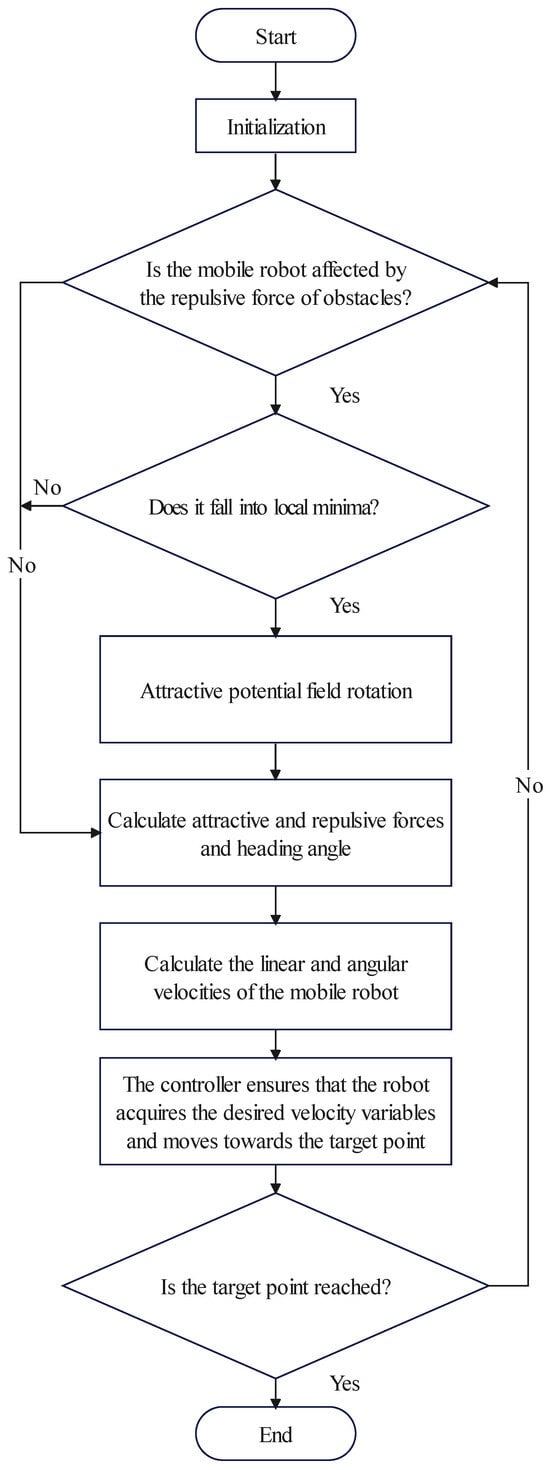
Figure 4.
Flowchart of the attractive potential field rotation method.
4. Simulations and Experimental Validation
This section validates the path planning and control strategy of the proposed method for health-monitoring tasks in unstructured scenarios through the use of MATLAB simulations and Turtlebot3 experiments.
4.1. Simulation Results and Analysis
Mobile robots are often deployed in complex and varied environments, such as hospitals and nursing homes. To effectively navigate these areas and avoid obstacles, thereby ensuring the efficient completion of health-monitoring tasks, robust planning and navigation capabilities are essential. We evaluate our proposed method in a 120 m × 120 m simulation environment, where the robot navigates through the potential fields defined in (10). A high-density environment comprising 30 randomly generated obstacles was established, and the influence range of the obstacles was set to a sufficiently large value. This aims to facilitate the emergence of local minima and the GNRON problem to illustrate the advantages of the proposed method. The start and target coordinates were set to (0,0) and (100,100), respectively. When constructing the attractive potential field function, a nonlinear function is typically employed, such as an exponential or a logarithmic function. In cases where computational complexity is challenging, a polynomial can be utilized to fit the function. We set with , , and . The remaining parameter settings are provided in Table 1.

Table 1.
Planning parameters in random dense obstacle environments.
The parameters that play an important role are the attraction and repulsion scale factors and the repulsion influence range. The latter can be large enough to cover the trajectory of the robot moving to the target point. The former lacks a discernible size range and order of magnitude and needs to be selected based on specific map information. The selection principle is as follows. First, the attraction cannot increase indefinitely with the distance between the robot and the target point. Second, when there are obstacles near the target point, the attractive force can exceed the growth rate of the repulsive force such that the robot can reach the target point.
A total of 100 comparative simulations are conducted for the traditional artificial potential field (TAPF), the rotating traditional attractive potential field (RT-APF), and the rotating improved attractive potential field (RI-APF) as proposed in this paper, all under the previously described environmental and parameter configurations. The detailed simulation results are provided in Table 2.

Table 2.
One hundred comparative simulation results of three methods in random dense obstacle environments.
The effectiveness of each simulation was assessed based on the number of successful instances in which the mobile robot reached the designated target point. Failures were categorized into two groups: those due to collisions with obstacles and those caused by the robot’s inability to reach the target point within 3000 control cycles. From the simulation results in Table 2, it can be seen that RI-APF significantly improves the success rate of the mobile robot reaching the target point, although the path length generated by this method increased slightly. Since the rotating attractive potential field is used to overcome local minima, it is difficult to avoid having to travel a longer distance to bypass obstacles. Furthermore, the standard deviations of the success cases of the three methods are not much different because they all calculate the attraction and repulsion based on the distance of the mobile robot from the target point and obstacles.
In numerous experiments, the TAPF method fails to identify the optimal path in the maximum number of iterations. This is due to the inherent limitations of the gradient descent method, which causes the robot to converge towards local minima. From the perspective of potential field theory, this can be interpreted as the robot falling into a pit during its descent and being unable to disengage from it. From the perspective of forces, it can be seen that the repulsive and attractive forces applied to the robot cancel each other out, thus preventing the robot from moving forward. When the map is large, the size of the attractive force is proportional to the distance between the robot and the target point. Therefore, excessive attractive force will cause the robot to easily collide with obstacles during the movement. Furthermore, most previous studies on potential fields place the target point in a position that is not affected by obstacles. If the obstacle is near the target point, the repulsive force will be significantly greater than the attractive force, and the robot will not be able to reach the target point. The above problems also appear quite frequently in our simulation results, as shown in Figure 5, Figure 6, Figure 7 and Figure 8.
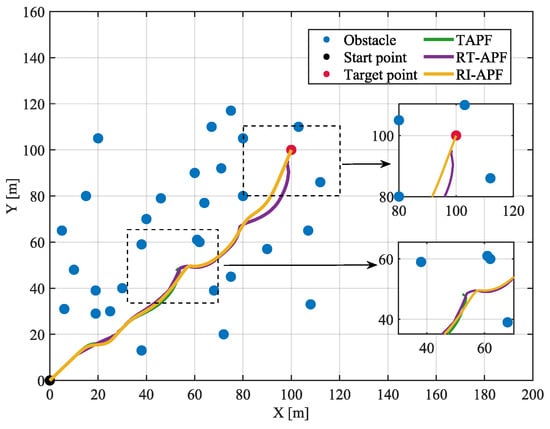
Figure 5.
GNRON arises from the positioning of target points near obstacles.
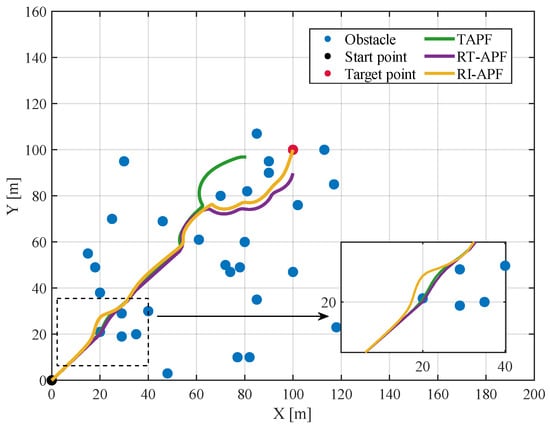
Figure 6.
Excessive distance results in the failure of both TAPF and RT-APF obstacle avoidance.
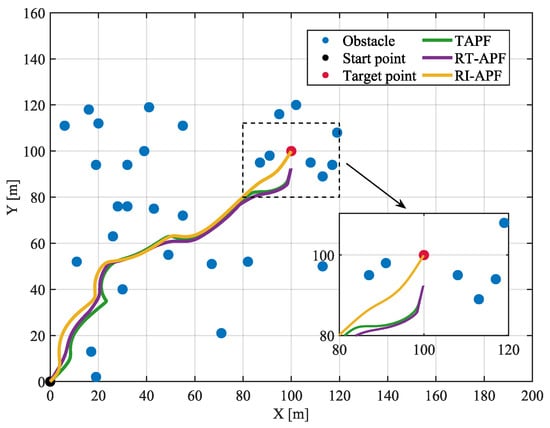
Figure 7.
RT-APF facilitates the avoidance of local minima that may be encountered during the driving process.
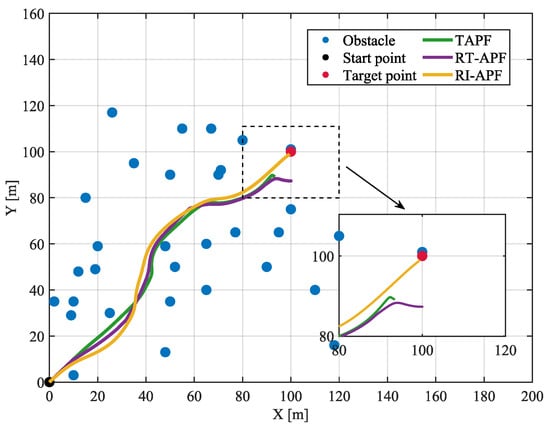
Figure 8.
RI-APF failure example.
As illustrated in Figure 5, RT-APF can effectively assist TAPF in overcoming local minima. Nevertheless, the GNRON problem remains difficult to solve. When the robot is situated at an excessive distance from the target point, the considerable attraction prevents TAPF and RT-APF from effectively avoiding obstacles near the starting point, as shown in Figure 6. Moreover, randomly generated obstacles near the target point present a significant challenge for both TAPF and RT-APF. These obstacles exert considerable repulsive forces while the attractive force toward the target point diminishes. This problem, known as GNRON, is illustrated in Figure 7.
RI-APF can be regarded as an improvement of RT-APF, which can effectively solve all the aforementioned problems. However, we observed failures in some simulations, as illustrated in Figure 8. These failures occur when random obstacles are very close to or overlap with the target point, a scenario that is uncommon in practical tasks.
To further validate the effectiveness of the three methods in obstacle avoidance, two distinct local minima were designed in a 6 m × 4 m simulation environment, with the target point situated at a reasonable distance from obstacles. The corresponding simulation results are presented in Figure 9.
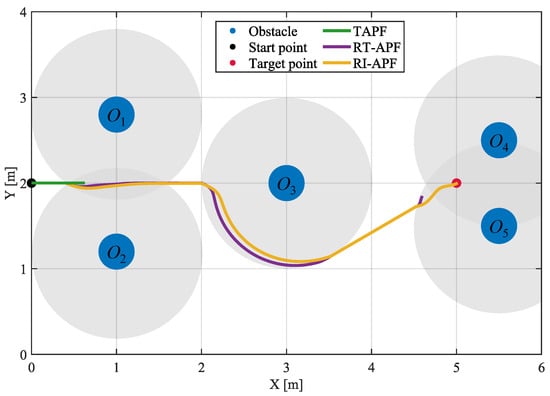
Figure 9.
Comparison of obstacle avoidance performance under fixed obstacles and local minima.
The start and target points of the mobile robot are (0,2) and (5,2), respectively. The global coordinates of the five fixed obstacles are as follows: , , , , and . For environments with small maps and simple obstacle configurations, the requirement that the attraction must remain bounded as the distance between the robot and the target point tends to infinity is not stringent. For simplicity, we set the . The remaining parameters are presented in Table 3.

Table 3.
Planning parameters under fixed obstacles and local minima.
The attractive force can be combined with the repulsive forces of , , and , leading the mobile robot to fall into local minima, as illustrated in Figure 9. However, rotating the attractive potential field can effectively overcome this issue. Furthermore, the RI-APF method proposed in this paper successfully addresses the GNRON problem. The specific changes in attractive and repulsive forces are illustrated in Figure 10.
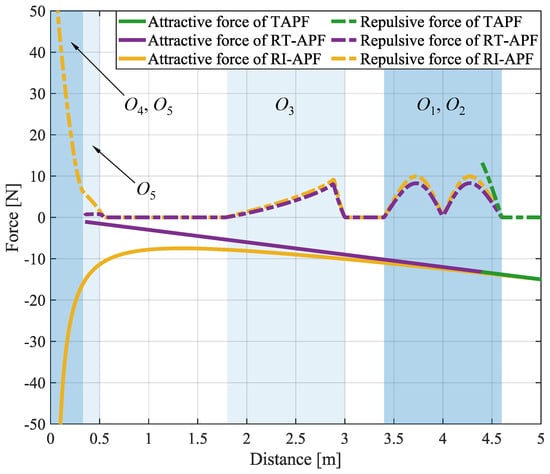
Figure 10.
Variation in attractive and repulsive forces under fixed obstacles and local minima. The blue area indicates the repulsive force exerted by each obstacle on the mobile robot.
4.2. Experimental Results and Analysis
To validate the effectiveness of our planning and control strategy in real-world health-monitoring scenarios, we perform experiments using a mobile robot within actual physical environments.
The experimental environment is configured similarly to the setup used in the fixed obstacles and local minima simulation, as illustrated in Figure 9. The mobile robot selected for this experiment is the Turtlebot3 Burger. The platform is a differential drive robot with a nonholonomic constraint on its velocity, rendering it unable to move in the direction of the wheel axis, i.e., in the direction as in Figure 1. The estimation of the robot’s state based on sensor measurements may be influenced by uncertain dynamics, mechanical constraints, and measurement noise. To mitigate these challenges, a vision-based motion capture system is employed to directly obtain the Cartesian position information required by the controller. Additionally, an upper limit on the linear and angular velocity of the Turtlebot3 Burger is imposed, namely m/s and rad/s, based on the finite dynamics of the mobile robot.
The trajectory of the mobile robot with our proposed RI-APF method is shown in Figure 11. The results of multiple experimental paths show that their trajectories and path lengths are not significantly different from the simulation results in Figure 9. The entire experimental process is documented in Figure 12. The robot is attracted only by the attraction of the target point at the beginning, and it encounters two fixed local minima at s and s, respectively. However, it successfully overcomes the local minima by the rotation of the attractive potential field and maintains its forward progress at s and s. As the robot approaches the target point, the attraction decreases. Since the target point is set near obstacles, the GNRON problem begins to emerge when s. The improved attractive force solves the problem with a faster growth rate, allowing the robot to ultimately reach the target point.
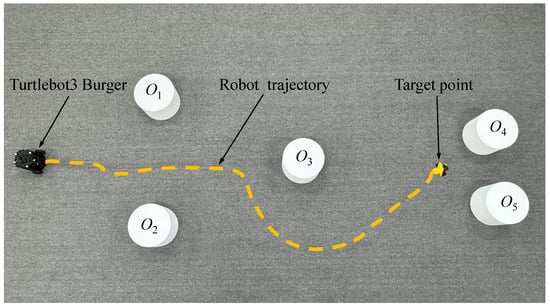
Figure 11.
Comparison of obstacle avoidance performance under fixed local minima.
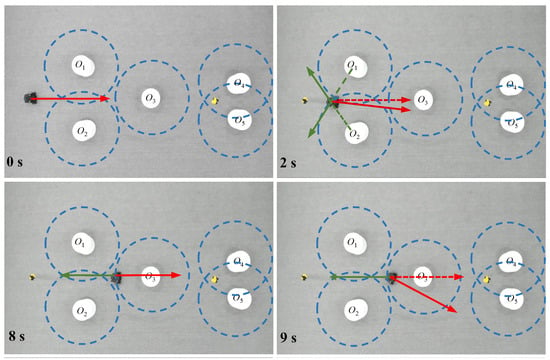
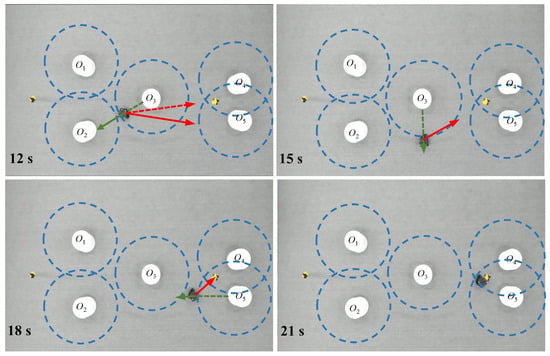
Figure 12.
Obstacle avoidance experiment for a mobile robot under fixed local minima. The green arrow illustrates the direction of the repulsive force acting on or expected to act on the robot. The solid red arrow indicates the actual direction of the robot’s attractive force, while the dashed red arrow shows the direction of the attractive force before the attractive potential field is rotated.
5. Discussion
The simulation and experimental results of the traditional artificial potential field method and the two methods proposed in this paper show that there are significant differences in the performance of the three methods in mobile robot path planning and obstacle avoidance. As shown in Figure 5, Figure 6 and Figure 7, although TR-APF can effectively help TAPF overcome local minima, it performs poorly in long-range tasks and GNRON problems, and there is even the possibility of collision. RI-APF can effectively solve the above problems and generate fairly smooth paths. In contrast, in a slightly more complex environment, TAPF cannot reach the target point at all. This demonstrates the advantage of the RI-APF algorithm, which is to create a more efficient path through an improved attractive potential field.
This paper proposes a path planning and control strategy based on artificial potential fields, aiming to overcome the limitations of traditional potential fields and apply them to practical health monitoring. Overcoming local minima by rotating the attractive potential field typically requires circumventing obstacles, which means that the RI-APF method may require a slightly longer travel path. However, the significant improvement in ensuring task completion justifies this trade-off.
6. Conclusions and Future Work
The application of mobile robots to health monitoring presents significant challenges, particularly in navigation and control within unstructured environments. This paper proposes a new class of attractive potential fields based on the traditional artificial potential field to address the GNRON problem and the collision caused by excessive attraction triggered by a position that is too far away from the target point. In addition, the paper proposes a method for rotating the attractive potential field to effectively overcome local minima. Comparative simulations of the traditional attractive potential field and the improved attractive potential field, rotated in a dense random obstacle environment and a fixed local minima environment, were performed. The experimental results demonstrate that the rotation of the improved attractive potential field is an effective solution to the aforementioned problems. Finally, the effectiveness and feasibility of the method proposed in this paper are verified through experiments on the Turtlebot3 Burger mobile robot platform. Future work will focus on more complex environments, such as hospitals and nursing homes, taking into account the movement of people and dynamic obstacles to achieve safer and more efficient navigation and control.
Author Contributions
Methodology, Y.L.; Investigation, Y.J.; Formal analysis, Y.L.; Writing—original draft, Y.L.; Writing—review and editing, H.S.; Validation, Y.L.; Project administration, L.Z. All authors have read and agreed to the published version of the manuscript.
Funding
This research was funded by the Natural Science Foundation of China under Grant 62403319.
Data Availability Statement
Data are contained within the article.
Conflicts of Interest
The authors declare no conflicts of interest.
References
- Cao, H.; Xiong, H.; Zeng, W.; Jiang, H.; Cai, Z.; Hu, L.; Zhang, L.; Lu, W. Safe reinforcement learning-based motion planning for functional mobile robots suffering uncontrollable mobile robots. IEEE Trans. Intell. Transp. Syst. 2024, 25, 4346–4363. [Google Scholar] [CrossRef]
- Liu, Y.; Tao, X.; Li, X.; Colombo, A.W.; Hu, S. Artificial intelligence in smart logistics cyber-physical systems: State-of-the-arts and potential applications. IEEE Trans. Ind. Cyber-Phys. Syst. 2023, 1, 1–20. [Google Scholar] [CrossRef]
- Wu, Y.; Zhu, X.; Fei, J.; Xu, H. A novel joint optimization method of multi-agent task offloading and resource scheduling for mobile inspection service in smart factory. IEEE Trans. Veh. Technol. 2024, 73, 8563–8575. [Google Scholar] [CrossRef]
- Mišeikis, J.; Caroni, P.; Duchamp, P.; Gasser, A.; Marko, R.; Mišeikiene, N.; Zwilling, F.; Castelbajac, C.D.; Eicher, L.; Früh, M.; et al. Lio-a personal robot assistant for human-robot interaction and care applications. IEEE Rob. Autom. Lett. 2020, 5, 5339–5346. [Google Scholar] [CrossRef] [PubMed]
- Pequeño-Zurro, A.; Ignasov, J.; Ramírez, E.R.; Haarslev, F.; Juel, W.K.; Bodenhagen, L.; Krüger, N.; Shaikh, D.; Rañó, I.; Manoonpong, P. Proactive control for online individual user adaptation in a welfare robot guidance scenario: Toward supporting elderly people. IEEE Trans. Syst. Man Cybern. Syst. 2023, 53, 3364–3376. [Google Scholar] [CrossRef]
- Su, Z.; Liang, F.; Do, H.M.; Bishop, A.; Carlson, B.; Sheng, W. Conversation-based medication management system for older adults using a companion robot and cloud. IEEE Rob. Autom. Lett. 2021, 6, 2698–2705. [Google Scholar] [CrossRef]
- Stogl, D.; Armbruster, O.; Mende, M.; Hein, B.; Wang, X.; Meyer, P. Robot-based training for people with mild cognitive impairment. IEEE Rob. Autom. Lett. 2019, 4, 1916–1923. [Google Scholar] [CrossRef]
- Du, G.; Li, Y.; Su, K.; Li, C.; Liu, P.X. A mobile natural human-robot interaction method for virtual Chinese acupuncture. IEEE Trans. Instrum. Meas. 2023, 72, 5001110. [Google Scholar] [CrossRef]
- Wang, M.; Pan, C.; Ray, P.K. Technology entrepreneurship in developing countries: Role of telepresence robots in healthcare. IEEE Eng. Manag. Rev. 2021, 49, 20–26. [Google Scholar] [CrossRef]
- Keroglou, C.; Kansizoglou, I.; Michailidis, P.; Oikonomou, K.M.; Papapetros, I.T.; Dragkola, P.; Michailidis, I.T.; Gasteratos, A.; Kosmatopoulos, E.B.; Sirakoulis, G.C. A survey on technical challenges of assistive robotics for elder people in domestic environments: The ASPiDA concept. IEEE Trans. Med. Rob. Bionics 2023, 5, 196–205. [Google Scholar] [CrossRef]
- Khatib, O. Real-time obstacle avoidance for manipulators and mobile robots. Int. J. Robot. Res. 1986, 5, 90–98. [Google Scholar] [CrossRef]
- Xi, W.; Tan, X.; Baras, J.S. Gibbs sampler-based coordination of autonomous swarms. Automatica 2006, 42, 1107–1119. [Google Scholar] [CrossRef]
- Najafi, M.; Rossa, C.; Adams, K.; Tavakoli, M. Using potential field function with a velocity field controller to learn and reproduce the therapist’s assistance in robot-assisted rehabilitation. IEEE/ASME Trans. Mechatron. 2020, 25, 1622–1633. [Google Scholar] [CrossRef]
- Xie, S.; Hu, J.; Bhowmick, P.; Ding, Z.; Arvin, F. Distributed motion planning for safe autonomous vehicle overtaking via artificial potential field. IEEE Trans. Intell. Transp. Syst. 2022, 23, 21531–21547. [Google Scholar] [CrossRef]
- Sun, S.; Guo, H.; Wan, G.; Dong, C.; Zheng, C.; Wang, Y. High-precision underwater acoustic localization of the black box utilizing an autonomous underwater vehicle based on the improved artificial potential field. IEEE Trans. Geosci. Remote Sens. 2023, 61, 4202510. [Google Scholar] [CrossRef]
- Gao, Y.; Bai, C.; Fu, R.; Quan, Q. A non-potential orthogonal vector field method for more efficient robot navigation and control. Rob. Auton. Syst. 2023, 159, 104291. [Google Scholar] [CrossRef]
- Sun, C.; Hu, G.; Xie, L.; Egerstedt, M. Robust finite-time connectivity preserving coordination of second-order multi-agent systems. Automatica 2018, 89, 21–27. [Google Scholar] [CrossRef]
- Chen, Y.; Bai, G.; Zhan, Y.; Hu, X.; Liu, J. Path planning and obstacle avoiding of the USV based on improved ACO-APF hybrid algorithm with adaptive early-warning. IEEE Access 2021, 9, 40728–40742. [Google Scholar] [CrossRef]
- Pan, Z.; Zhang, C.; Xia, Y.; Xiong, H.; Shao, X. An improved artificial potential field method for path planning and formation control of the multi-UAV systems. IEEE Trans. Circuits Syst. II Express Briefs 2022, 69, 1129–1133. [Google Scholar] [CrossRef]
- Kim, J.-O.; Khosla, P.K. Real-time obstacle avoidance using harmonic potential functions. IEEE Trans. Robot. Autom. 1992, 8, 338–349. [Google Scholar] [CrossRef]
- Wang, P.; Gao, S.; Li, L.; Sun, B.; Cheng, S. Obstacle avoidance path planning design for autonomous driving vehicles based on an improved artificial potential field algorithm. Energies 2019, 12, 2342. [Google Scholar] [CrossRef]
- Gottardi, A.; Tortora, S.; Tosello, E.; Menegatti, E. Shared control in robot teleoperation with improved potential fields. IEEE Trans. Hum.-Mach. Syst. 2022, 52, 410–422. [Google Scholar] [CrossRef]
- Tian, Y.; Zhu, X.; Meng, D.; Wang, X.; Liang, B. An overall configuration planning method of continuum hyper-redundant manipulators based on improved artificial potential field method. IEEE Rob. Autom. Lett. 2021, 6, 4867–4874. [Google Scholar] [CrossRef]
- Zhang, W.; Xu, G.; Song, Y.; Wang, Y. An obstacle avoidance strategy for complex obstacles based on artificial potential field method. J. Field Rob. 2023, 40, 1231–1244. [Google Scholar] [CrossRef]
- Song, J.; Hao, C.; Su, J. Path planning for unmanned surface vehicle based on predictive artificial potential field. Int. J. Adv. Rob. Syst. 2020, 17, 1–13. [Google Scholar] [CrossRef]
- Rostami, S.M.H.; Sangaiah, A.K.; Wang, J.; Liu, X. Obstacle avoidance of mobile robots using modified artificial potential field algorithm. EURASIP J. Wirel. Commun. Netw. 2019, 2019, 70. [Google Scholar] [CrossRef]
- Pang, W.; Zhu, D.; Sun, C. Multi-AUV formation reconfiguration obstacle avoidance algorithm based on affine transformation and improved artificial potential field under ocean currents disturbance. IEEE Trans. Autom. Sci. Eng. 2024, 21, 1469–1487. [Google Scholar] [CrossRef]
- Shin, Y.; Kim, E. Hybrid path planning using positioning risk and artificial potential fields. Aerosp. Sci. Technol. 2021, 112, 106640. [Google Scholar]
- Luo, G.C.; Yu, J.Q.; Mei, Y.S.; Zhang, S.Y. UAV path planning in mixed-obstacle environment via artificial potential field method improved by additional control force. Asian J. Control 2015, 17, 1600–1610. [Google Scholar] [CrossRef]
- Chen, Y.B.; Luo, G.C.; Mei, Y.S.; Yu, J.Q.; Su, X.L. UAV path planning using artificial potential field method updated by optimal control theory. Int. J. Syst. Sci. 2016, 47, 1407–1420. [Google Scholar] [CrossRef]
- Wang, D.; Wang, P.; Zhang, X.; Guo, X.; Shu, Y.; Tian, X. An obstacle avoidance strategy for the wave glider based on the improved artificial potential field and collision prediction model. Ocean Eng. 2020, 206, 107356. [Google Scholar] [CrossRef]
- Yang, C.; Pan, J.; Wei, K.; Lu, M.; Jia, S. A novel unmanned surface vehicle path-planning algorithm based on A* and artificial potential field in ocean currents. J. Mar. Sci. Eng. 2024, 12, 285. [Google Scholar] [CrossRef]
- Chen, J.; Tan, C.; Mo, R.; Zhang, H.; Cai, G.; Li, H. Research on path planning of three-neighbor search A* algorithm combined with artificial potential field. Int. J. Adv. Rob. Syst. 2021, 18, 1–13. [Google Scholar] [CrossRef]
- Sang, H.; You, Y.; Sun, X.; Zhou, Y.; Liu, F. The hybrid path planning algorithm based on improved A* and artificial potential field for unmanned surface vehicle formations. Ocean Eng. 2021, 223, 108709. [Google Scholar] [CrossRef]
- Dai, J.; Zhang, Y.; Deng, H. Novel potential guided bidirectional RRT* with direct connection strategy for path planning of redundant robot manipulators in joint space. IEEE Trans. Ind. Electron. 2023, 71, 2737–2747. [Google Scholar] [CrossRef]
- Pharpatara, P.; Hérissé, B.; Bestaoui, Y. 3-D trajectory planning of aerial vehicles using RRT*. IEEE Trans. Control Syst. Technol. 2016, 25, 1116–1123. [Google Scholar] [CrossRef]
- Huang, Z.; Chu, D.; Wu, C.; He, Y. Path planning and cooperative control for automated vehicle platoon using hybrid automata. IEEE Trans. Intell. Transp. Syst. 2018, 20, 959–974. [Google Scholar] [CrossRef]
- Rasekhipour, Y.; Khajepour, A.; Chen, S.K.; Litkouhi, B. A potential field-based model predictive path-planning controller for autonomous road vehicles. IEEE Trans. Intell. Transp. Syst. 2016, 18, 1255–1267. [Google Scholar] [CrossRef]
- Receveur, J.B.; Victor, S.; Melchior, P. Autonomous car decision making and trajectory tracking based on genetic algorithms and fractional potential fields. Intell. Serv. Rob. 2020, 13, 315–330. [Google Scholar] [CrossRef]
- Szczepanski, R. Safe artificial potential field-novel local path planning algorithm maintaining safe distance from obstacles. IEEE Rob. Autom. Lett. 2023, 8, 4823–4830. [Google Scholar] [CrossRef]
- Goricanec, J.; Milas, A.; Markovic, L.; Bogdan, S. Collision-free trajectory following with augmented artificial potential field using UAVs. IEEE Access 2023, 11, 83492–83506. [Google Scholar] [CrossRef]
- Yang, F.; Wang, C.L. Adaptive stabilization for uncertain nonholonomic dynamic mobile robots based on visual servoing feedback. Acta Autom. Sin. 2011, 37, 857–864. [Google Scholar] [CrossRef]
- Wang, G. Consensus algorithm for multiagent systems with nonuniform communication delays and its application to nonholonomic robot rendezvous. IEEE Trans. Control Netw. Syst. 2023, 10, 1496–1507. [Google Scholar] [CrossRef]
- Wang, G. Distributed control of higher-order nonlinear multi-agent systems with unknown non-identical control directions under general directed graphs. Automatica 2019, 110, 108559. [Google Scholar] [CrossRef]
Disclaimer/Publisher’s Note: The statements, opinions and data contained in all publications are solely those of the individual author(s) and contributor(s) and not of MDPI and/or the editor(s). MDPI and/or the editor(s) disclaim responsibility for any injury to people or property resulting from any ideas, methods, instructions or products referred to in the content. |
© 2024 by the authors. Licensee MDPI, Basel, Switzerland. This article is an open access article distributed under the terms and conditions of the Creative Commons Attribution (CC BY) license (https://creativecommons.org/licenses/by/4.0/).